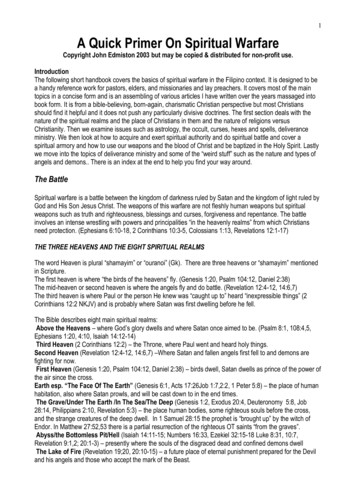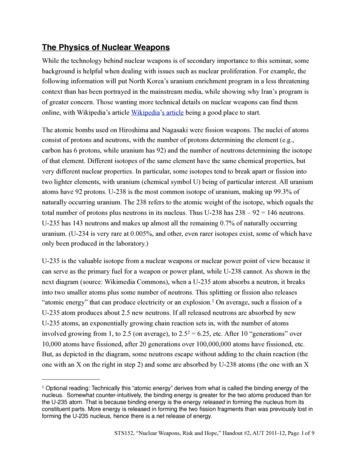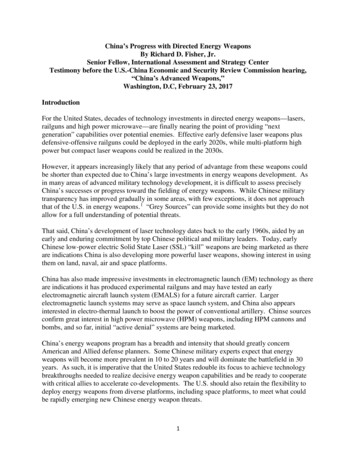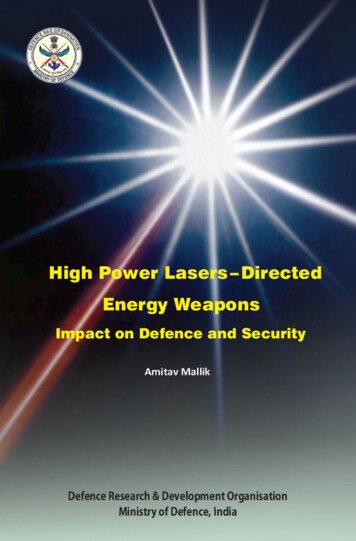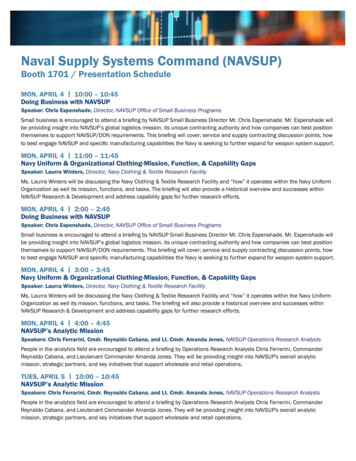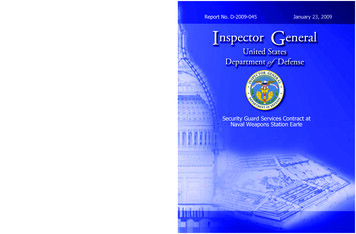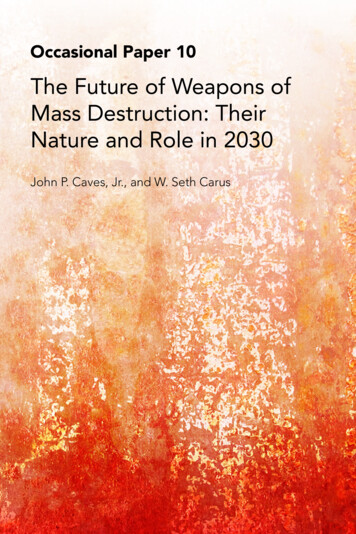
Transcription
Occasional Paper 10The Future of Weapons ofMass Destruction: TheirNature and Role in 2030John P. Caves, Jr., and W. Seth Carus
Center for the Study of Weapons of Mass DestructionNational Defense UniversityDR. JOHN F. REICHARTSenior DirectorMR. JOHN P. CAVES, JR.Deputy Director, Distinguished Research FellowSince its inception in 1994, the Center for the Study of Weapons of MassDestruction (WMD Center) has been at the forefront of research on theimplications of weapons of mass destruction for U.S. security. Originally focusingon threats to the military, the WMD Center now also applies its expertise andbody of research to the challenges of homeland security. The Center’s mandateincludes research, education, and outreach. Research focuses on understandingthe security challenges posed by WMD and on fashioning effective responsesthereto. The Chairman of the Joint Chiefs of Staff has designated the Center asthe focal point for WMD education in the joint professional military educationsystem. Education programs, including its courses on countering WMD andconsequence management, enhance awareness in the next generation ofmilitary and civilian leaders of the WMD threat as it relates to defense andhomeland security policy, programs, technology, and operations. As a part of itsbroad outreach efforts, the WMD Center hosts annual symposia on key issuesbringing together leaders and experts from the government and private sectors.Visit the center online at wmdcenter.dodlive.mil.
The Future of Weapons ofMass Destruction: TheirNature and Role in 2030John P. Caves, Jr., and W. Seth CarusCenter for the Study of Weapons of Mass DestructionOccasional Paper, No. 10National Defense University PressWashington, D.C.June 2014
Opinions, conclusions, and recommendations expressed or impliedwithin are solely those of the contributors and do not necessarily representthe views of the Defense Department or any other agency of the FederalGovernment. Cleared for public release; distribution unlimited.Portions of this work may be quoted or reprinted without permission, provided that a standard source credit line is included. NDU Presswould appreciate a courtesy copy of reprints or reviews.First printing, June 2014
ContentsForeword . . . . . . . . . . . . . . . . . . . . . . . . . . . . . . . . . . . . . . . . . . . . . . . . . 1Acknowledgments. . . . . . . . . . . . . . . . . . . . . . . . . . . . . . . . . . . . . . . . . . 3Executive Summary . . . . . . . . . . . . . . . . . . . . . . . . . . . . . . . . . . . . . . . . . 4Introduction. . . . . . . . . . . . . . . . . . . . . . . . . . . . . . . . . . . . . . . . . . . . . . . 8WMD in 2014. . . . . . . . . . . . . . . . . . . . . . . . . . . . . . . . . . . . . . . . . . . . . . 9WMD-Relevant Technological Trends. . . . . . . . . . . . . . . . . . . . . . . . . . 24WMD-Relevant Geopolitical Trends . . . . . . . . . . . . . . . . . . . . . . . . . . . 31WMD in 2030. . . . . . . . . . . . . . . . . . . . . . . . . . . . . . . . . . . . . . . . . . . . . 38Policy Considerations. . . . . . . . . . . . . . . . . . . . . . . . . . . . . . . . . . . . . . . 48Notes. . . . . . . . . . . . . . . . . . . . . . . . . . . . . . . . . . . . . . . . . . . . . . . . . . . . 52About the Authors. . . . . . . . . . . . . . . . . . . . . . . . . . . . . . . . . . . . . . . . . 63
The Future of Weapons of Mass DestructionForewordIn 2011, the Center for the Study of Weapons of Mass Destructionlaunched a project to envision the future of weapons of mass destruction(WMD). It chose the year 2030 as its time horizon. During the first year, weconducted a series of roundtable discussions with experts on global trendsin political-military and technological developments. These discussions had abroad range and were not limited to WMD matters. During the second year,we established several working groups to focus on the WMD implicationsof future trends. Science and technology was the principal remit for the firstgroup, geopolitics for the second, and military matters for the third, but allthree groups concurrently considered the panoply of developments that couldimpact the future of WMD. While there was a great deal of commonalityamong each group’s findings, differences also emerged. As there can be no onedefinitive forecast of the future, but at best only educated guesses, the WMDCenter chose to publish more than one set of findings rather than to producea single integrated report. The Center thus hopes to enrich the larger debateabout the future of WMD and to afford U.S. policymakers multiple perspectives to consider as they decide where to steer U.S. efforts to counter tomorrow’s WMD dangers.John Caves and Seth Carus authored one set of findings. Mr. Caves co-chaired the project’s working group whose principal remit was geopolitics, andDr. Carus was the co-lead for the overall project. Their paper herein principally considers how the intersection of geopolitical and technological trendsmay shape the nature and role of WMD in 2030. Forrest Waller authoredanother set of findings. Mr. Waller led the project’s working group whoseprincipal remit was science and technology. Fittingly, Mr. Waller’s forthcom-ing paper is first and foremost an examination of how science and technologytrends may affect WMD by 2030. Both papers offer recommendations for U.S.policymakers in preparing for the envisioned WMD futures.1
CSWMD Occasional Paper 10Dr. Carus, Mr. Caves, and Mr. Waller benefited greatly from the insights andsupport of many others, and particularly our colleagues at the WMD Center. I amprivileged to direct a center staffed with such outstanding individuals.—Dr. John F. ReichartSenior DirectorWMD CenterNational Defense University2
The Future of Weapons of Mass DestructionAcknowledgmentsWhile the authors are solely responsible for the final content of their respec-tive papers, they were able to reach their findings only as the result of the time andexpertise freely availed to them by many knowledgeable individuals and organiza-tions. Foremost among them are their colleagues in the Center for the Study ofWeapons of Mass Destruction, who contributed to the development of this paperand participated in the center’s larger project on the future of WMD. Of particularnote are Dr. John Reichart, director of the WMD Center; Mr. Robert Peters, co-lead for the overall project and co-chair of the working group on military matters;Mr. Brendan Melley, co-chair of the working group on geopolitics; and Dr. JohnMark Mattox, co-chair of the working group on military matters. Also of note areMr. Paul Bernstein, Mr. Richard Love, Mr. Charles Lutes, Dr. Shane Smith, Ms.Lorena Bedford, Mr. Kenneth Rapuano, and Ambassador Linton Brooks.Among the many individuals from outside the Center who helped make thisproject possible are leaders and experts of the Pacific Northwest National Labo-ratory, Sandia National Laboratories, Lawrence Livermore National Laboratory,Los Alamos National Laboratory, Air Force Research Laboratory in Albuquer-que, the Center for International Security and Cooperation at Stanford University,Naval Postgraduate School, Monterrey Institute for International Studies, Centerfor Science, Technology, and Policy at the University of New Mexico, CentralIntelligence Agency, and the Office of the Director of National Intelligence.We also are indebted to the many current and former U.S. Government of-ficials and experts who participated in one or more of the center’s several workshops for the project. We further benefited from a highly productive exchange ofideas on the future of WMD during a workshop with knowledgeable representatives from the United Kingdom Ministry of Defence and the British Embassy inWashington, DC.3
CSWMD Occasional Paper 10Executive SummaryThe longstanding efforts of the international community writ large to ex-clude weapons of mass destruction (WMD) from international competition andconflict could be undermined in 2030. The proliferation of these weapons is likelyto be harder to prevent and thus potentially more prevalent. Nuclear weapons arelikely to play a more significant role in the international security environment,and current constraints on the proliferation and use of chemical and biologicalweapons could diminish. There will be greater scope for WMD terrorism, thoughit is not possible to predict the frequency or severity of any future employment ofWMD. New forms of WMD—beyond chemical, biological, radiological, and nuclear weapons—are unlikely to emerge by 2030, but cyber weapons will probablybe capable of inflicting such widespread disruption that the United States maybecome as reliant on the threat to impose unacceptable costs to deter large-scalecyber attack as it currently is to deter the use of WMD. The definition of weaponsof mass destruction will remain uncertain and controversial in 2030, and its value asan analytic category will be increasingly open to question.These conclusions about the future of WMD derive from judgments about rel-evant technological and geopolitical developments out to 2030. Technological developments will shape what WMD capabilities will be achievable in that timeframewhile geopolitical developments will shape motivations to acquire and use WMD.Technologically, by 2030, there will be lower obstacles to the covert develop-ment of nuclear weapons and to the development of more sophisticated nuclearweapons. Chemical and biological weapons (CBW ) are likely to be 1) more accessible to both state and nonstate actors due to lower barriers to the acquisitionof current and currently emerging CBW technologies; 2) more capable, particu-larly in terms of their ability to defeat current or currently emerging defensivecountermeasures; 3) more discriminate; that is, more precisely targeted and/ormore reliably low- or nonlethal; and 4) harder to attribute (utilizing hithertounknown agents and/or delivery mechanisms) than the traditional forms knowntoday. No major new technological developments regarding radiological weapons are foreseen.4
The Future of Weapons of Mass DestructionGeopolitically, the United States will remain the world’s most powerful coun-try through 2030 but will be less dominant in an increasingly multipolar international system. Nonstate groups, potentially including terrorists, will grow in ca-pabilities and importance. Sources of international conflict will remain and couldintensify, and the risks for armed conflict, both inter- and intrastate, will grow.The “battle of narratives” will be an increasingly important part of armed conflict.Taken together, these developments and characteristics point to a world thatin 2030 will be more prosperous, technologically capable, and connected, but onewhose international relations will be more competitive and uncertain. The world’sgains will not be distributed equally, and its constituents will be more keenly awareof the inequalities. While the United States should remain the single most powerful actor, it will not be hegemonic. The share of global power held by Washingtonand its Western allies will have declined significantly. Pax Americana will be fading, but a new order policed by a similarly dominant power will not yet be visiblemuch less in place. The commitment of the rising powers to the pillars of PaxAmericana, including its nonproliferation norms and regimes, will be tested.More states are likely to cleave to or seek out the perceived security of nuclearweapons in this more uncertain environment, and some may test the political andmilitary utility of new biological and chemical weapons capabilities made possibleby technological developments, especially in the life sciences. There will be greaterscope for WMD terrorism. Of particular concern will be how the diffusion ofWMD technologies will increase the capacity of small groups and even lone ac-tors, whose motivations and actions are inherently less subject to prediction andcontrol, to acquire and employ the technologies of mass destruction even if doneinadvertently.How should the United States prepare for such a future? Since no future ispreordained, it first must devote attention to shoring up the means by which ithas been able to mitigate the spread and use of WMD to date: 1) sustaining itswill and ability to meet its extended deterrence commitments and the benefittingallies’ perception thereof; 2) universalizing and deepening the international commitment to the principles, tenets, and implementation of the WMD nonprolifera-tion norms and regimes; and 3) identifying, acquiring, and deploying the means5
CSWMD Occasional Paper 10to detect, track, and monitor the emerging technical means by which WMD canbe developed and concealed.Whatever success the United States and like-minded nations can achieve inthe above three areas should mitigate the anticipated future WMD challengesbut should not be relied on to wholly preclude them. Therefore, the United Statesmust also prepare for the above-described WMD circumstances of 2030. Foremost is recognizing that America and other countries are likely to become morereliant on deterrence and less on prevention to counter the dangers of a moreWMD-proliferated world. This will put a premium on investing in the key attributes of effective deterrence: an unambiguous capacity to impose unacceptablecosts on WMD-armed adversaries; the ability to defeat limited WMD attacks,particularly through missile defense and homeland security measures; the abil-ity to attribute WMD attacks; and the effective strategic communication of ourdeterrence capabilities and will to employ them.Nuclear weapons will figure prominently in the deterrence strategies of a num-ber of states in 2030. It will be imperative for the United States to maintain a ro-bust, reliable, and credible nuclear deterrent force in that environment. Accordingly,Washington should preferentially fund the modernization of its nuclear arsenal andsupporting infrastructure to ensure a credible and effective nuclear deterrent to 2030and beyond. Deterring and responding to adversary nuclear weapons threats andpotential employment must also figure more prominently and systemically in U.S.military plans, as well as in the education of U.S. military and civilian national secu-rity leaders, so the United States is better prepared to manage escalation challengesamidst increasing nuclear risks.Washington further needs to anticipate and prepare for the possible reemer-gence of chemical and biological warfare as novel and more effective forms ofthese weapons emerge from rapid advances in the life sciences over the next twodecades. Washington should assume that it will encounter the employment ofhitherto unknown chemical and biological agents in military and civilian environ-ments, and will need to develop a mindset, approaches, and capabilities for recog-nizing and responding to unknown agent attacks. It also should continue to investin broad-spectrum defensive countermeasures that are better able to recognize,6
The Future of Weapons of Mass Destructionprotect against, and treat a wide range of chemical and biological threats. Further-more, it should be prepared to alter its negative security assurances with regard tothe employment of U.S. nuclear weapons to respond to a heightened biological orchemical weapons threat from nonnuclear weapons states.With specific regard to WMD terrorism, the greater accessibility that ter-rorists should have to current and currently-emerging WMD technologies, andparticularly those relating to CBW, will require the United States to maintainintense and multifaceted efforts to dissuade such entities from seeking WMDand prevent them from employing them. While it is not known what has mostaccounted for the paucity of terrorist use of even cruder forms of WMD to date,or at least employment that has resulted in mass destruction, the combination ofstrong international norms, intense law enforcement and military pressure, andimproved defenses likely have all contributed to this desired outcome. It is onlyprudent to sustain and, where possible, intensify this multitude of deliberate obstacles to terrorist acquisition and employment of WMD.While the future cyber threat may foster consideration of strategic responsescomparable to those made to the WMD threat, it would seem inappropriate andpossibly disadvantageous to the United States to apply the WMD moniker tocyber weapons at this time. WMD have been given special priority for eliminationor control. Several treaties also place specific limitations on their use, and makingcyber weapons a form of WMD would automatically make those provisions apply.Until the United States better understands whether it wants to develop an inter-national regime constraining cyberspace or to maximize its flexibility to utilize acapability in which it is the acknowledged world leader, there are no advantages totreating cyber weapons as WMD.7
CSWMD Occasional Paper 10IntroductionThis paper explores the possible nature and role of weapons of mass destruc-tion (WMD) in the 2030 timeframe. That is, it endeavors to describe what willconstitute WMD in that timeframe and why and to what extent actors may pur-sue, acquire, and even employ such weapons. It is a product of the Center for theStudy of Weapons of Mass Destruction’s Project on the Future of WMD, an effortthat began in late 2010 and involved consultations with a range of governmentofficials and other experts as well as a literature review on relevant technologicaland geopolitical trends.The Center undertook this study keenly appreciative of the limitations in-herent to any effort to project future developments, particularly beyond 5 years.We nonetheless hoped that thoughtful consideration about what might tran-spire with WMD over the longer term could usefully inform nearer term U.S.Government plans and investments for countering WMD that might have longer term implications.We understand that the role of WMD will be shaped to a greater or lesserextent by political, military, economic, and social forces that are themselves dif-ficult to predict. In addition, we realize that the policies adopted and the actionstaken by the U.S. Government will affect the shape of the future both for thesecurity environment and for WMD in particular. For these reasons, we offer apicture of the future security environment painted with broad-brush strokes andgenerally avoid associating wide-reaching developments with specific foreign actors or circumstances.However, we are sensitive to the need for prudence; therefore, we focus onplausible developments that could pose serious challenges. Thus, for example, weconsider it both more likely and prudent to assume that China, an emerging greatpower, will continue its rise, increasing the costs and risks to the United States ofsustaining its current international position and security commitments. Fewer re-grets are likely to attend U.S. international security interests if the Nation preparesfor this future rather than for a less challenging alternative. Indeed, accepting thatsome dangers are more likely may help stimulate U.S. leaders to take actions to8
The Future of Weapons of Mass Destructionsustain U.S. national power over the longer term, such as measures to stimulateeconomic growth and manage the deficit.Envisioning the future of WMD entails challenges beyond only those associ-ated with projecting future developments generally. Because WMD have so seldom been employed, and countries that possess such weapons tend to be secretiveabout these capabilities and their intentions regarding them, there is a paucity offactual information from which to extrapolate on why countries will seek WMDand how they are likely to use them. Perhaps the most important and challengingquestion today is why these weapons have so seldom been employed, particularlythose chemical, biological, and radiological weapons that are considered accessibleto the violent extremists who are believed to be the most likely to employ them.Theories abound, but none can be proven; hence judgments about the future ofWMD tend to be more intuitive than empirical.Our judgments about the nature and role of WMD in the 2030 timeframeare developed in five sections. The first offers baseline observations about WMDin 2014. The second considers how technological trends could shape the natureand accessibility of WMD in 2030. The third discusses geopolitical trends thatcould influence how state and nonstate actors will view WMD in 2030. Thefourth makes judgments about the role of WMD in 2030 in light of the foregoing discussion of technological and geopolitical developments. The final sectionoffers considerations for U.S. policy in preparing for the WMD challenge of2030 that we envision.WMD in 2014This section offers observations about WMD today, providing a baseline forour exploration of potential changes during the coming two decades.For the purposes of this paper, weapons of mass destruction are defined aschemical, biological, radiological, and nuclear (CBRN) weapons. While it mayseem unnecessary to make this observation, in actuality there are a variety ofdefinitions of WMD in current use.1 Here we chose to adopt the official UnitedNations (UN) definition, which is used for disarmament, diplomacy, and armscontrol treaties:9
CSWMD Occasional Paper 10Atomic explosive weapons, radioactive material weapons, lethalchemical and biological weapons and any weapons developed in thefuture which might have characteristics comparable in destructiveeffect to those of the atomic bomb or other weapons mentioned above.2As a practical matter, the UN definition is interpreted as applying to allCBRN weapons even if they are not necessarily lethal. Significantly, this defi-nition originated in the late 1940s to support the UN disarmament agenda byidentifying weapons categories that deserved special consideration for eliminationor control. So far, the international community has rejected attempts to expandWMD beyond CBRN weapons. Mindful that the UN definition explicitly allowsfor the possibility of entirely new forms of WMD emerging in the future—thatis, other than CBRN—we address the prospects for that occurring by 2030 laterin this paper.There are several problems with the UN definition. Some types of CBRweapons can be employed to inflict discrete effects while conventional weaponscan be employed in ways that are massively destructive. As a result, the UN definition includes weapons that may be incapable of causing either mass destructionor mass fatalities, while excluding some that actually have caused mass death anddestruction. Thus, radiological weapons are now seen as the most likely to causerelatively localized effects. Many biological and chemical agents can be used inhighly discriminate ways, including assassinations, and some chemical and bio-logical agents such as foot and mouth disease may be useful mainly for disruption.Moreover, different types of WMD can have different political-military effects.For example, as discussed later, we believe that CBR weapons do not have thesame deterrent effect as nuclear weapons. Finally, conventional weapons can beemployed en masse to generate effects comparable to those of nuclear weapons, asevident from the impact of conventional bombing during World War II. It is alsotelling that more people were killed in the Rwanda genocide by simple weaponsthan have died from all uses of WMD in war.3Alternative definitions are no more satisfactory. Some add high explosives(in the United States, this occurs mainly in the law enforcement community),10
The Future of Weapons of Mass Destructionwhich impractically would treat virtually all weapons of war used by modern militaries as WMD. Others count only those types of CBRN weapons that cross acertain vaguely-defined threshold of “mass destruction” or lethality, but there isno widely accepted definition of what constitutes mass destruction. Another approach would define WMD as weapons that are especially abhorrent and thussubjected to exceptional controls or outright prohibition. Yet while this is the casefor CBRN weapons, for much of the international community it also is true forother types of weapons, such as antipersonnel landmines and cluster munitions.The international community writ large seeks to exclude WMD from internationalcompetition and conflict. Only the five original nuclear weapons states are authorized under international law to possess nuclear weapons, and they are obligatedby Article VI of the 1970 Nuclear Nonproliferation Treaty (NPT) to work to-ward the abolition of all nuclear weapons in the context of general and completedisarmament. Renewed attention and commitment to the achievement of thatgoal, including by the Obama administration, has followed Henry Kissinger, SamNunn, William Perry, and George Shultz’s articulation of a vision for the eventualelimination of all nuclear weapons in a January 2007 Wall Street Journal editorial.4 Biological and chemical weapons are prohibited to all States Parties by the1975 Biological and Toxins Weapons Convention (BWC) and the 1997 ChemicalWeapons Convention (CWC), respectively. There is, however, an exception in theCWC for nonlethal chemical agents used for law enforcement purposes that mayloom larger in the future. Interestingly, no comparable treaty exists to prohibitradiological weapons, although there have been efforts to negotiate one.5The achievement of these instruments’ goals is supported by other interna-tional nonproliferation agreements, regimes, programs, and initiatives, such asa number of regional nuclear weapons-free zone treaties, the Nuclear SuppliersGroup and Australia Group, cooperative threat reduction programs, the GenevaProtocol, the Outer Space and Seabed treaties, and the Proliferation SecurityInitiative, as well as by ongoing efforts to extend the nuclear weapons controlregime by bringing the Comprehensive Nuclear Test Ban Treaty into force andnegotiating a Fissile Material Cutoff Treaty.6 Indeed, it could be argued thatthe international community has effectively marginalized the military role of11
CSWMD Occasional Paper 10chemical and biological weapons, and only nuclear weapons are seen to retainutility as a deterrent.WMD proliferation is currently a limited problem set. Almost all states belongto, and are deemed compliant with, the major nonproliferation treaties. In 2013,Syria, a longstanding CWC holdout, joined the convention and agreed to a de-tailed plan for the elimination of its declared CW stocks and capabilities. In January 2014, Libya completed the elimination of its declared CW program.7 Thesewere important recent gains for the cause of WMD nonproliferation.A few countries, however, remain outside one or more of the aforementionedtreaties that proscribe WMD. India, Israel, and Pakistan have never accepted theNPT, and North Korea withdrew in 2003. Egypt, North Korea, South Sudan, andAngola have never joined the CWC, while Israel and Burma have signed but notratified it. A somewhat larger number of states, mostly in Africa but includingIsrael, have never joined the BWC, and others including Egypt and Syria havesigned but not ratified it. In addition, a few of the States Parties to one or moreof these nonproliferation agreements are suspected of violating their obligationsunder them. Iran figures most prominently among them, but the United Stateshas questions about aspects of Russia’s, China’s, and a few others’ compliance withone or more of the treaties.8 India and Pakistan, two of the four nuclear weaponsstates outside the NPT, are also a major concern because many think that conflict between these two rivals has the most potential to lead to an actual nuclearweapons exchange. Further, there is concern about the potential for some or all ofPakistan’s nuclear weapons to fall under the control of radical Islamists active inthe country either through an illicit acquisition or an assumption of state power.There have been two major adverse proliferation developments in recentyears: North Korea’s self-proclaimed acquisition of nuclear weapons, supportedby three nuclear device tests; and Iran’s suspected pursuit of nuclear weapons,supported inter alia by its refusal to heed the UN Security Council Resolutionsthat it suspend uranium enrichment and demonstrate that its nuclear program isstrictly for peaceful purposes. While North Korea’s nuclear weapons program re-mains largely unconstrained, negotiations among Iran and the P5 1 states (China,France, Germany, Russia, the United Kingdom, and the United States) produced12
The Future of Weapons of Mass Destructionan interim agreement in November 2013 to freeze most aspects of Iran’s nuclearprogram. This agreement is to be in effect for 6 months pending the negotiationof a permanent accord that would align Iran’s nuclear endeavors with internationalexpectations.Fears that these adverse proliferation developments will spur regional rivals,many of them U.S. allies, to seek their own nuclear weapons (which some havecalled a “nuclear cascade”) have not been borne out to date. Similar fears dur-ing the 1960s went largely unrealized. Whereas in 1963 President John Kennedyforesaw the possibility of 15 to 20 new nuclear weapons states within a decade,9the actual proliferation pattern since has been more like one per decade. Thatthe worst fears of nuclear proliferation then did not materialize had much to dowith concerted efforts b
National Defense University DR. JOHN F. REICHART Senior Director MR. JOHN P. CAVES, JR. Deputy Director, Distinguished Research Fellow Since its inception in 1994, the Center for the Study of Weapons of Mass Destruction (WMD Center) has been at the forefront of research on the implications of weapons of mass destruction for U.S. security.





